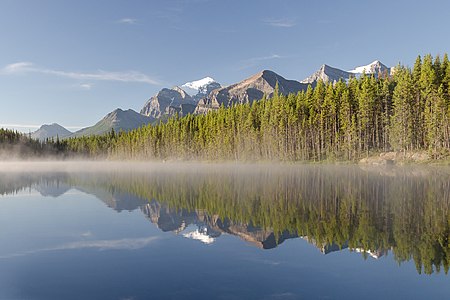Mist
This article needs additional citations for verification. (January 2009) |


Mist is a phenomenon caused by small droplets of water suspended in air. Physically, it is an example of a dispersion. It is most commonly seen where warm, moist air meets sudden cooling, such as in exhaled air in the winter, or when throwing water onto the hot stove of a sauna. It can be created artificially with aerosol canisters if the humidity and temperature conditions are right. It can also occur as part of natural weather, when humid air cools rapidly, for example when the air comes into contact with surfaces that are much cooler than the air.
The formation of mist, as of other suspensions, is greatly aided by the presence of nucleation sites on which the suspended water phase can congeal. Thus even such unusual sources as small particulates from volcanic eruptions, releases of strongly polar gases, and even the magnetospheric ions associated with polar lights can in right conditions trigger the formation of mist and can make mirrors appear foggy. Mist on mirrors should not be mistaken for condensation as they are very different. Mist is a collection of water droplets but condensation is the water droplets in a different form.
Mist is commonly mistaken for fog, which resembles a stratus cloud lying at ground level. These two phenomena differ, yet share some common things. Similar processes form fog and mist. Fog is denser and generally lasts longer, but mist is thinner and more transparent.
Description
Cloud cover is often referred to as "mist" when encountered on mountains, whereas moisture suspended above a body of water or marsh area is usually called "fog". One difference between mist and fog is visibility.[1] The phenomenon is called fog if the visibility is 1 km (1,100 yd) or less. In the U.K., the definition of fog is visibility less than 100 m (330 ft) (for driving purposes, UK Highway Code rule 226),[2] while for pilots the distance is 1 km. Otherwise, it is known as mist.
Mist makes a light beam visible from the side via refraction and scattering on the suspended water droplets.
"Scotch mist" is a light steady drizzle.
Mist usually occurs near the shores and is often associated with fog. Mist can be as high as mountain tops when extreme temperatures are low.
Snow
Freezing mist is similar to freezing fog, only the density is less and the visibility greater (when fog falls below 0 °C (32 °F), it is known as freezing fog).[3]
-
Mist lying in the folds of hills, Australia
-
Sunlight through mist on a crisp winter morning
-
Misty morning at Swifts Creek
-
Mist on a lake
-
Curitiba, Brazil
-
Labugama, Sri Lanka
See also
References
- ^ "Archived copy". Archived from the original on 2012-12-10. Retrieved 2006-01-16.
{{cite web}}: CS1 maint: archived copy as title (link) - ^ "Driving in adverse weather conditions (226 to 237)". gov.uk. Government of the United Kingdom.
- ^ {{cite web |url=http://www.theweatherprediction.com/habyhints/359/ |title=What Is Difference Between Ice Fog and Freezing Fog?






